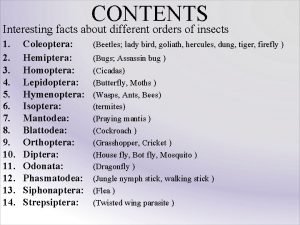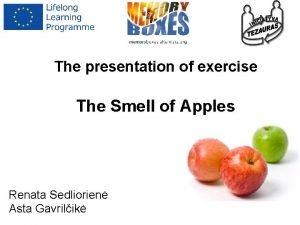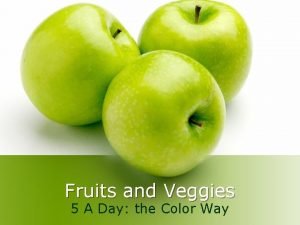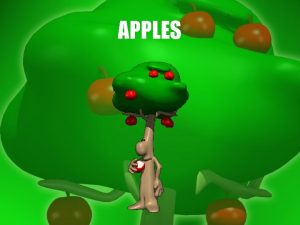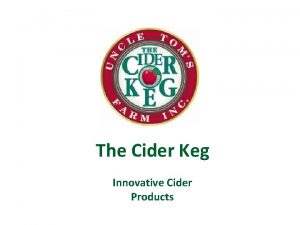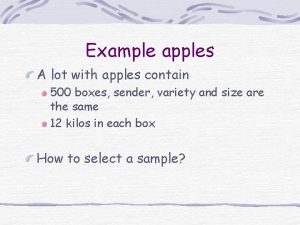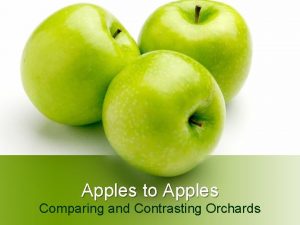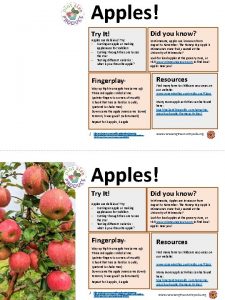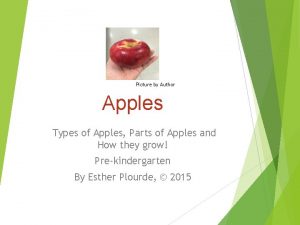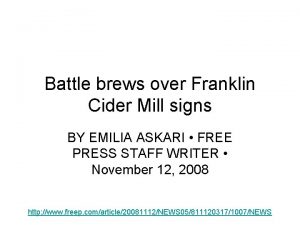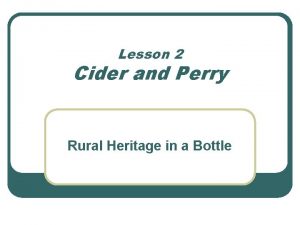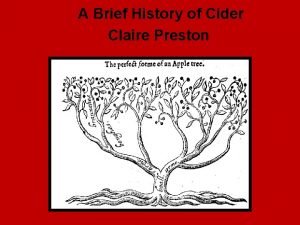Colorado Apples for the Colorado Cider Industry Can

















































- Slides: 49

Colorado Apples for the Colorado Cider Industry Can we grow premium apples for the High-End Cider Market?

Brad Page Owner Colorado Cider Company Established 2010

• The French, Spanish and Britons all grew apples which thrived on both sides of the English Channel • The new American Colonist brought apples from England France and found they grew well in the Colonies. • Beer was not made in great quantity until large migrations of Germans and Central Europeans in the 19 th century. Not a lot of barley grown in the wilds of the colonies

• Founders or the United States were avid apple enthusiast and made hard cider • Benjamin Franklin was credited with bringing the Albemarle Pippin (or Newton Pippin) to England when he was Ambassador and causing a little export business of this Long Island apple • Jefferson was obsessed with growing the Esopus Spitzenburg in Virginia (finding limited success)

Cider thrived in North America where production and consumption was relatively local • Were the colonist planting classic European Varieties or were they just planting seeds a la Johnny Appleseed? • What was the primary reason for growing apples? • Obviously if the founders had varieties that the were trying to specifically grow there was a grafting tradition being followed. • If you were in a covered wagon maybe you weren’t so picky • In any case people were making hard cider and it was wide spread up to the middle of the 19 th century but never really saw large scale manufacturing

The Temperance Movement and Prohibition An accepted narrative explaining the demise of hard cider in the United States is that the temperance movement focused on it as a source of drunkenness. It had developed into a poor man’s drink that often had spirit added and was of low quality. With the rise of modern brewing techniques and centralized industrial breweries the popularity of cider all but disappeared. The apples that people associate with making cider were not desirable for eating and therefore the orchards were plowed under. Prohibition came much later (1920 with the Volstead Act) and probably had little effect on the already scarce drink. (repealed with the 21 st amendment in 1933) What prohibition did accomplish was the consolidation of the brewing industry by closing many breweries that did not open with its repeal. The shrunken number of manufacturers and the onset of World War II changed the way beer was brewed (rice, corn to make up for scarce barley crops) and the lightening of beer was fully under way.

Decline in number of Breweries • 1873 there were 4, 131 • 1890 there were 2, 156 • 1919 there were 669 • 1934 there were 756 • 1941 there were 857 • 1978 there were 89

The rise of Craft Beer Does it foreshadow the rise of Craft Cider? • 43 years after the repeal of prohibition • New Albion Brewing Company in California 1976 • Homebrew act passed 1979 • Boulder Brewing Company 1979 • Sierra Nevada Brewing Company 1980 • The race was on

All Malt Beer in the United States in 1980 was almost exclusively made with a mixture of malted barley and adjuncts such as rice and corn. The practice came out of the war but it had developed into a style and was much cheaper to make than a beer made with all malted barley. This is what people thought beer should taste like. Hops were used but they were less and less emphasized. There were vey few large domestic breweries making dark beers much less hoppy beers.

Specialty Malts Craft Brewers started using malt that had been roasted to give beer a depth of flavor based on traditional, mostly English, styles of beer. All of the sudden you had beer with color, and different flavors based on those malts that were from red to black. (few domestic producers)

Hops have been an essential element of beer for many centuries but the amounts used in common commercial beers were so low as to almost be imperceptible. Along came breweries like Sierra Nevada that were using hopping rates many times what commercial beers had. Those initial craft beer hopping rates would be considered low today but were radical at the time.

Yeast Brewers making Ales started using Yeasts that imparted flavors that were different from traditional Lager yeasts. All the sudden yeasts used at warmer temperatures were adding fruity esters to beer and it opened a whole other range of flavors.

Where is the Craft Beer Industry Today? 6, 372 as of January 1 st, 2018


That’s a lot of beer • Barrel = 31 gallons • Total Beer Sold in the U. S. in 2017 was 6, 084, 633, 190 gallons • “Craft” share was 770, 916, 556 gallons (12. 7%) • What is craft?



Colorado and Oregon • Colorado • Oregon • 348 Craft Breweries (Ranks 3 rd) • 8. 4 Breweries per Capita (Ranks 5 th) • 1, 523, 204 Barrels of Craft beer produced per year (Ranks 3 rd) • 11. 4 Gallons per Adult (Ranks 5 th ) • 266 Craft Breweries (Ranks 7 th) • 8. 5 Breweries per Capita* (Ranks 4 th) • 1, 078, 391 Barrels of Craft beer produced per year (Ranks 9 th) • 10. 7 Gallons per Adult (Ranks 6 th) Brewers Association Statistics 2017

Why talk about Oregon? • Very similar craft beer market with Colorado • Unusually high cider consumption compared to Colorado • They have a 4% beer equivalent while Colorado is less than 1%

Northwest Cider Association • 90 Members out of 150 cideries • 2/3 rds make less than 10, 000 gallons per year • Close to 5 Million gallons of cider produced • Cultural? • Horticultural? • Beer fatigue?

Colorado Cider Guild • Formed in 2012 (formerly Rocky Mountain Cider Assoc. ) • 4 initial members (1 remaining) • Currently 15 producers in Colorado • Estimated 2018 production of 600, 000

What we would need to produce • Assuming Colorado Cider Producers made 600, 000 gallons of cider in 2018 they would need: • 6, 000 pounds of apples • Roughly 7, 500 bins

What is the point of all this? What does it have to do with me growing apples?

What does Craft Beer have to do with Hard Cider? • Connection with drink and alcohol industry in the U. K. (it’s influence on the U. S. industry) • Alcohol levels are similar • Vast majority of cider is consumed in a manner much more similar to beer than wine • Currently there are many that argue that the new drinkers of cider are coming from the craft beer segment (not at the expense of but in addition to) • There was no industry of craft beverage that proceeded the craft beer movement while cider is benefiting from the development of the craft beer segment • There a host of cider makers that come from the craft beer movement

Volume of Cider Sales in the U. K. • Brits consume 50% of all the cider world wide • The United States will change this percentage. By how much? • Common number used in the U. K. for volume is 15% equivalence of their beer consumption • If we take that number (in the U. S. ) and apply it to the overall beer market in the United States we’d come up with: • 15% of 196 million Barrels (6 Billion gallons) would be 29 million Barrels (900 million gallons) That’s a lot of apples (10 billion pounds? ) • What % of this will be niche high end “cider-apple” derived cider?

This industry is ingredient and flavor driven The market evolves as do people’s pallets • The beers that were made back in the 80’s were fairly simple – ingredients weren’t readily available and the public at large weren’t ready for a drastic shock to the senses • It took time for people to embrace some of the “wilder” styles of beer from Europe and for American Brewers to experiment beyond those traditional styles • Cider is following a similar trajectory

CIDER “INDUSTRY” • United States Association of Cidermakers • Rocky Mountain Cider Association • Cider Institute of North America • Colorado Cider Guild

Current Cidery Count (U. S. ) 860 From less than 50 in 2008

What is Cider made from? Apples, right? • Common Styles 1. Industrial Ciders – Often made in breweries (Angry Orchard) 2. with low apple juice content, large amounts of concentrate and adjuncts – SUGAR!! – ARTIFICIAL FLAVORS!!

This is somewhat an outgrowth of the wine cooler segment of the market. The big producers would be happy moving on to Hard Seltzer if they thought they could sell more of it. There are some smaller producers making this stuff


2. All Juice Ciders – Primarily Dessert Fruit • Many craft cideries out there use all juice to make their products • Back sweetening using juice or concentrate is common • Some producers make completely dry ciders • Other fruits such as cherry or berry might be used • Other whole ingredients might be used such as hops and other botanical ingredients • Access to true cider apples is limited

The Core Issue • Washington has a lot of apples • You can’t compete with their table fruit culls • Pricing for fresh pressed juice: • $2 per gallon delivered • That works out to $0. 13 per pound for apples (pressed) • $. 07 for transportation • That’s $108 per bin (800 lbs) pressed FOB Yakima • Yikes

3. Orchard Based or Orchard Connected Cider Producers Cider Makers using traditional cider apples most often grown themselves. These apples have no other use than for making hard cider. They may blend with some heirloom varieties but are dedicated to showcasing the flavors of these apples.

What is a “Cider” Apple? • Bittersweet • Bittersharp • Sweet

Bittersweets: containing high tannins and sugars, provide structure, and a certain breadth of aromas & flavors as well as range of sensation, deeper fruit and some of the high tropical perfumes. Varieties such as Dabinett, Yarlington Mill, Chisel Jersey, Ellis Bitter, Ashton Bitter, Somerset Redstreak, Medaille d’Or, and many others. Source: Poverty Lane Orchards

Bittersharps: containing high tannins & acid, contribute considerable flavor as above, but also critically important acid for clean fermentation and stimulating taste. Varieties include Kingston Black, Stoke Red, Foxwhelp. Of these, Kingston Black is the most famous back in Britain, and has long been used for single-variety ciders there. Other varieties are Frequin Rouge, Mettais Source: Poverty Lane Orchards

Sharps: Low sugar, high acid, low tannins. Examples are Granny Smith and Rhode Island Greening, Golden Russet, Roxbury Russet,

Sweets: High sugar, low tannin, low acid. Cider varieties include: Ashmead’s Kernel, Court Royal, Sweet Copin.

What are most cider makers interested in growing? 1. Tannin 2. Flavors that will survive fermentation These would best be found in Bittersweet and Bittersharp varieties some heirloom varieties will also make great cider

What about dual purpose apples? Heirloom Varieties? • We had 5 acres of Winesap we bulldozed about 10 years ago. . ! • Can growers get a premium for heirloom juice apples and for the fresh market? • Does the rise of the cider industry pull along the appreciation of heirloom apple varieties?

Why would I want to grow these apples? I hear they’re strange, fussy and not easy to come by • This a potential niche market for growers in Colorado • If we believe that the market for cider will grow (volume) and evolve (flavor) then there will be a demand for these varieties

• Will cider makers pay more for these varieties? • Yes, if they are available for sale • A grower in New Hampshire used to send a truck to the West Coast and cidermakers paid $24 per bushel for the fruit. • How long until there’s too much fruit? Who knows. • Is there a difference in these varieties grown in Colorado and elsewhere? • There’s a belief that there will be a certain terroir established in different parts of the country.

Cider as Wine • The consumer has not been buying the equivalent of a “Cabernet Sauvignon” when they buy cider • Virtually all cider is a blend of apple varieties. This is a strength when creating a category • Range of flavors is emphasized not varietals • What might grow in Colorado could be different than the rest of the country and be distinctive but still recognized as cider • Growers could pick varieties that bloom late but might still have tannin and good flavor – unlike the fresh market that emphasizes certain varieties for how they keep and beauty

Premium Cider Cost Breakdown 2. 38 Gallons Apples @ 11 lbs Juice @. 50/lb Pressing Caps Bottles Labels Freight $ $ $ $ 26. 18 13. 09 2. 86 0. 12 9. 20 4. 20 5. 81 35. 28 Distributor $ 88. 20 Retailer $ 126. 00 Bottle Price $ 15. 00




Conclusion We cider makers are confident that our industry is going to grow and we will want local fruit. Are we going to grow that fruit? Probably not. The “vision” is to form relationships with growers who we can work with to grow varieties of apples that allow us to make full flavor traditional ciders. We understand that this has to be a profitable endeavor on their part. Will we see contracts to grow this fruit? It’s difficult to see where the industry will be in 20 years but I think there can be a resurgent apple industry in Western Colorado that caters to this new alcoholic beverage Thank You!
 Apples juicy apples round poem
Apples juicy apples round poem Apples juicy apples round poem
Apples juicy apples round poem Apples here
Apples here Apples here apples there
Apples here apples there Gravity theory cider
Gravity theory cider Apush
Apush Atalanta and the golden apples summary
Atalanta and the golden apples summary Usp of apple company
Usp of apple company Whats a shinigami
Whats a shinigami The more you take the more you leave behind
The more you take the more you leave behind Www.youtube.com
Www.youtube.com Do beetles taste like apples
Do beetles taste like apples Apples syllable type
Apples syllable type Bert is standing on a ladder picking apples
Bert is standing on a ladder picking apples Melissa has 3 fewer apples than marcia
Melissa has 3 fewer apples than marcia Smell of apple
Smell of apple Nordic apples
Nordic apples The compound methyl butanoate smells like apples
The compound methyl butanoate smells like apples Apples friends
Apples friends Countable and uncountable nouns таблица
Countable and uncountable nouns таблица Paul cezanne basket of apples
Paul cezanne basket of apples Do you have any apples
Do you have any apples Underline the adjectives in each sentence below
Underline the adjectives in each sentence below Different colors of apples
Different colors of apples There are some apples on the table
There are some apples on the table Fspos
Fspos Typiska drag för en novell
Typiska drag för en novell Nationell inriktning för artificiell intelligens
Nationell inriktning för artificiell intelligens Ekologiskt fotavtryck
Ekologiskt fotavtryck Varför kallas perioden 1918-1939 för mellankrigstiden
Varför kallas perioden 1918-1939 för mellankrigstiden En lathund för arbete med kontinuitetshantering
En lathund för arbete med kontinuitetshantering Adressändring ideell förening
Adressändring ideell förening Tidböcker
Tidböcker A gastrica
A gastrica Vad är densitet
Vad är densitet Datorkunskap för nybörjare
Datorkunskap för nybörjare Boverket ka
Boverket ka Att skriva debattartikel
Att skriva debattartikel Delegerande ledarstil
Delegerande ledarstil Nyckelkompetenser för livslångt lärande
Nyckelkompetenser för livslångt lärande Påbyggnader för flakfordon
Påbyggnader för flakfordon Lufttryck formel
Lufttryck formel Offentlig förvaltning
Offentlig förvaltning Lyckans minut erik lindorm analys
Lyckans minut erik lindorm analys Presentera för publik crossboss
Presentera för publik crossboss Teckenspråk minoritetsspråk argument
Teckenspråk minoritetsspråk argument Bat mitza
Bat mitza Klassificeringsstruktur för kommunala verksamheter
Klassificeringsstruktur för kommunala verksamheter Mjälthilus
Mjälthilus Bästa kameran för astrofoto
Bästa kameran för astrofoto











